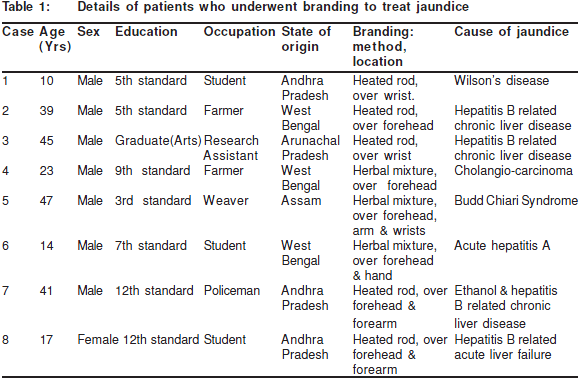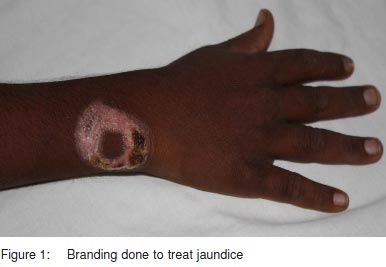48uep6bbphidvals|182
48uep6bbphidcol4|ID
48uep6bbph|2000F98CTab_Articles|Fulltext
Summary: Jaundice is regarded as a mysterious disease rather than a symptom of dis-ease in several parts of India. We describe 8 cases that underwent branding to treatjaundice and subsequently presented to our centre. The causes for jaundice in thesepatients included a variety of benign and malignant disorders. Our report suggests thatdespite being literate, strong cultural beliefs lead people to seek potentially harmful proce-dures like branding to treat jaundice in parts of India.
In societies where modern medicine is inaccessible to a large part of the population,patients seek branding to treat a variety of medical conditions.[1,2,3] A recent study from Indiashowed that jaundice was amongst the commonest complaints for which patients optedfor traditional / alternative forms of treatment.[4] Branding refers to a traditional practicewhereby third degree ‘therapeutic’ burns are inflicted on the skin with a hot iron rod ormetallic object to treat various conditions. These ancient methods are crude and inhu-mane, causing the treatment to be more unbearable than the original complaint and evencarry the risk of complications.[2] Complications arising from branding include acute infec-tion, transmission of blood-borne pathogens, allergic reactions, and sequelae arisingfrom third-degree burns.[2,3,4,5,6] The practice of putting saliva / ash / herbal paste on the burnwounds adds to the morbidity.[7]
We interviewed 8 patients seen recently at our centre who had undergone branding astreatment of jaundice to find out their perceptions about their illness and its treatment,using a semi-structured format. The questionnaire was administered by one investigator(SIJ). This study was approved by our Institutional Ethics Committee.
From June 2008 to June 2009, we interviewed 8 patients who had undergone branding totreat jaundice. These patients presented to our centre as the jaundice persisted despitebeing treated with branding. All 8 patients regarded jaundice as a disease per se and notas a symptom of a disease process. The patients paid for branding either through gifts or in currency (upto 3000 rupees was paid by one patient).


All 8patients were at least primary school educated (one patientwas a graduate in Arts). The decision to opt for branding wasadvised by a near relative in each patient. But for local cellu-litis at the site of branding (Figure 1), we did not note anyother complication of branding in these patients.
Discussion
There is no record of how the practice of branding originatedbut it is believed to be centuries old. It has been premisedthat in ancient times traditional healers used hot rods to burstseptic boils or pressed them onto open wounds to cauterisethe infection. But gradually, the practice attained a sort ofreligious sanctity and began to be associated with local dei-ties and was advanced as a cure for common diseases likemalaria, jaundice, meningitis and convulsions.
This practise is still very much seen in villages even to-day, various body parts are branded for different diseases-the abdomen for malaria and jaundice, the neck or the fore-head for meningitis and the wrist for convulsions. The redhot rod is just one of the instruments used, others includeburning ropes and metal rings.[1]
In several parts of India, jaundice continues to be viewedas a mysterious phenomenon. The commonest cause ofjaundice in India is acute viral hepatitis – an illness whichresolves spontaneously. In parts of India, it is strongly be-lieved that branding cures jaundice. When the underlying dis-ease does not resolve spontaneously, patients present tothe hospital. In our report a variety of benign and malignantcauses of jaundice were noted. Our report suggests thatdespite being educated, strong cultural beliefs force peopleto undergo branding as a treatment of jaundice in India evenin the 21st century. Public education to elucidate the causesof jaundice and to highlight the potential harm of practiceslike branding to treat jaundice is urgently required in India.
References
-
http://www.india-today.com/itoday/20060123/branding.html
-
Raza S, Mahmood K, Hakeem , Polsky S, Haemel A, Rai SA, et al.Adverse clinical sequelae after skin branding: a case series.Journal of Medical Case Reports. 2009;3:25.
-
Kumar S, Kumar PR. Skin branding. J Postgrad Med. 2004;50:204.
-
Yadav RJ, Pandey A, Singh P. A study on acceptability of Indiansystem of medicine and homeopathy in India: results from theState of West Bengal. Indian J Public Health. 2007;51:47–9.
-
Karamanoukian R, Ukatu C, Lee E, Hyman J, Sundine M,Kobayashi M, et al. Aesthetic skin branding: a novel form of bodyart with adverse clinical sequela. J Burn Care Res. 2006;27:108–10.
-
Kaatz M, Elsner P, Bauer A. Body-modifying concepts and der-matologic problems: tattooing and piercing. Clin Dermatol.2008;26:35–44.
-
Adhisivam B, Gowtham R. Branding treatment of children in ruralIndia should be banned. BMJ. 2005;330:481.